Are you considering putting some vivid yellow flowers in your garden this year? The good news is that you can brighten up your planting space with an abundance of yellow flowers.
There are many lovely yellow blooms to be found on both perennials and annuals. Some of the most well-liked yellow flowers for your flower garden are examined in this article.
1. Gerbera Daisy

Scientific Name: Gerbera jamesonii
Plant Type: Perennial
Plant Size: 10 – 18 inches tall
Sun Exposure: Full or partial sun
Plant Zone: 8 – 10
Geographic Origin: South Africa
Gerbera daisies include three to four-inch blossoms, which will appeal to those who prefer large yellow flowers. Plants with bronze- or solid-coloured flowers are an option, as is a bicoloured yellow variation. Either way, these blooms are positioned six inches above their tangled foliage.
Gerbera daisies typically bloom from late spring to early autumn. Because they keep well in vases for a long time, they make especially great cut flowers. Make sure composted soil and adequate drainage are available for these daisies.
2. Jungle Geranium

Scientific Name: Ixora coccinea
Plant Type: Perennial
Plant Size: 4 – 6 feet
Sun Exposure: Full or partial sun
Plant Zone: 9 – 11
Geographic Origin: Southern India, Bangladesh, Sri Lanka
Hello, coffee connoisseurs! You won’t want to use the Jungle Geranium as a coffee substitute, but it does belong to that family. Alternatively, if you’re looking for a yellow-blooming shrub for a hedgerow, this is a great option.
The gorgeous mass of tiny, tubular blossoms on the Jungle Geranium gives the impression of one colossal flower when viewed from a distance. As long as it has access to a moderate amount of water, this plant is low-maintenance and attracts butterflies and hummingbirds well.
3. Lesser Celandine

Scientific Name: Ficaria verna
Plant Type: Perennial
Plant Size: 9 inches tall
Sun Exposure: Full sun to light shade
Plant Zone: 4a – 9b
Geographic Origin: Europe, West Asia
Lesser celandines are a member of the poppy family and are a popular choice for gardeners despite being primarily used as wildflowers. Because people used it to remove warts in the past, it got the nickname “wartweed.”
Lesser Celandines bloom with yellow, four-petaled flowers about an inch across. Because its appendage attracts ants, we advise planting Lesser Celandine away from your home.
4. Prickly Pear

Scientific Name: Opunita humifusa
Plant Type: Perennial
Plant Size: 8 feet and 6 inches tall
Sun Exposure: Full sun
Plant Zone: 4 – 11
Geographic Origin: North and South America
A Prickly Pear’s yellow flowers are a double-edged sword: while the fruit develops after the flower can be eaten, doing so can be unpleasant if you need the right equipment due to the cactus’s numerous small spines.
You can also consume the green paddle on which the fruit and flowers are growing. Ensure that the variety of prickly pear you select has yellow blossoms. Then, you will be able to appreciate the paper-thin, pointed-petalled blossoms that emerge.
5. Ranunculus

Scientific Name: Ranunculus asiaticus
Plant Type: Perennial
Plant Size: 1- 2 feet tall
Sun Exposure: Full sun
Plant Zone: 8 – 10
Geographic Origin: Mediterranean
Ranunculus belongs to the family of buttercups. Specifically, the Ranunculus asiaticus species is a wildflower that resembles buttercups, although it grows higher than other types. They are frequently found in open meadows.
The Ranunculus plant has yellow in different shades. Its yellow color may be duller if you see one in the wild. However, because of selective breeding, those you buy from a nursery frequently have a brilliant yellow colour.
6. Strawflower

Scientific Name: Xerochrysum bracteatum
Plant Type: Perennial
Plant Size: 2 – 3 feet tall
Sun Exposure: Full or partial sun
Plant Zone: 8 – 11
Geographic Origin: Australia
If you have the strawflower that seems dried out in the picture, you are exactly right. The stiff bract leaves of strawflowers resemble a flower’s petals.
Thus, even if their “flowers” aren’t actual, growing them in your garden will be enjoyable. The color of strawberries is a rich golden-yellow. They can grow in well-drained soil and stay “bloomy” from spring until autumn.
7. Yellow Butterfly Bush

Scientific Name: Buddleia davidii
Plant Type: Perennial
Plant Size: 4 – 12 feet tall
Sun Exposure: Full sun
Plant Zone: 5 – 9
Geographic Origin: China
You guessed it! A variety of butterflies are drawn to the yellow butterfly bush. But since it blooms in the late summer, you’ll have to wait for them.
The plant’s stems are covered in trumpet-shaped, yellowish-orange flowers that create a stunning triangle shape. Yellow Butterfly Bushes grow taller than they are wide. They are resilient to backyard deer and do not back down during a drought.
8. Yellow Yarrow

Scientific Name: Achillea millefolium
Plant Type: Perennial
Plant Size: 2 – 3 feet tall
Sun Exposure: Full sun
Plant Zone: 3 – 9
Geographic Origin: Northern hemisphere
The bright yellow mini-flowers of yellow yarrow develop giant flower heads when they are grouped densely. While yellow yarrow is often planted along borders, you can also come across it growing naturally in meadows.
The yellow yarrow has several excellent properties, including drought and insect resistance. You can dry these flowers and hang them in your house. Its flower heads also attract butterflies to the area.
9. Black-Eyed Susan

Scientific Name: Rudbeckia
Plant Type: Perennial
Plant Size: 2 – 3 feet tall
Sun Exposure: Full sun
Plant Zone: 3 – 7
Geographic Origin: Central United States
The ideal illustration of a wildflower that people welcome into their gardens is a black-eyed Susan. Their enormous yellow flowers, with a dark brown cone at the center of each, are supported by a robust stalk.
The petals of Black-Eyed Susan are symmetrical and oriented slightly downward as they mature. Their cones stick out in order to attract pollinators and those who appreciate this exquisite plant. The Black-Eyed Susan’s striking deep green leaves are the cherry on top.
10. Begonia
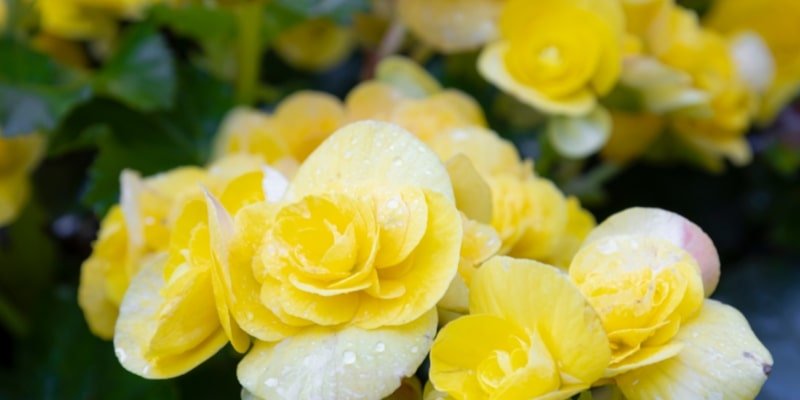
Scientific Name: Begonia oblique
Plant Type: Annual or perennial
Plant Size: 8 – 14 inches tall
Sun Exposure: Partial or full sun
Plant Zone: 9 – 11
Geographic Origin: Brazil
Tuberous plants called begonias form bushy mounds in the spring and summer. Take care where you plant them because they spread quickly; if you live in a warm environment where they act as a perennial, this is especially important.
There are many different colours of begonia flowers, so be sure to choose the yellow variety. From July through the early autumn, you will then be able to enjoy gorgeous flower clusters that are drooping. Begonia flowers have a citrus flavour; thus, some people use them in their cooking.
11. Bird of Paradise

Scientific Name: Strelitzia
Plant Type: Perennial
Plant Size: 3 – 4 feet tall
Sun Exposure: Partial or full sun
Plant Zone: 10 – 12
Geographic Origin: Africa
When one imagines tropical climates, the typical plant that comes to mind is the bird of paradise. It has a thick green petiole, from which arise its elaborate yellowish-orange blossoms.
Its two pointed petals are accompanied by a boat-shaped flower bract and five stamens. Rich, pervious soil is essential for the growth of birds of paradise. Moreover, it will flower more the more sun it receives.
12. Bidens
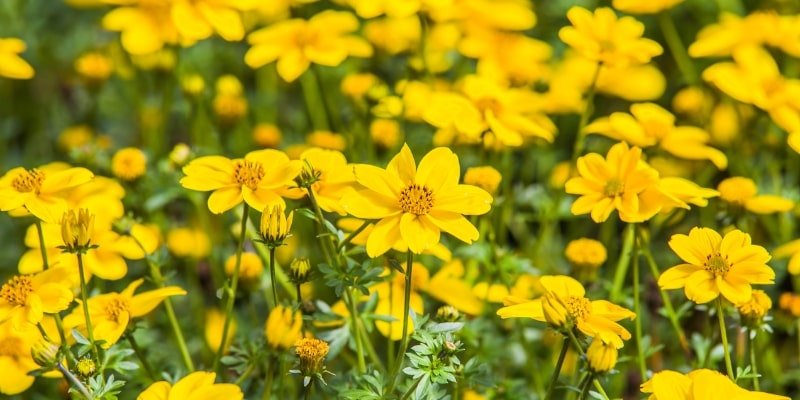
Scientific Name: Bidens
Plant Type: Depending on whether it’s annual or perennial and whether the temperature stays over 40 °F
Plant Size: 6 – 12 inches tall
Sun Exposure: Full or partial sun
Plant Zone: 8 – 11
Geographic Origin: Oceanic region
Bidens have rich yellow blossoms that resemble daisies. Their orange centers provide a striking contrast, giving the impression that they are fully formed yellow flowers. Bidens are beloved by gardeners because, in warmer regions, their foliage is evergreen.
You can anticipate many blooms from your bidens during the summer if you provide them with soil that is rich in nutrients and drains properly. Moreover, this plant will keep flowering even if you don’t deadhead it.
13. Busy Lizzie

Scientific Name: Impatiens walleriana
Plant Type: Perennial
Plant Size: 2 feet tall
Sun Exposure: Partial to full sun
Plant Zone: 10a – 11
Geographic Origin: East Africa
The impatiens known as “Busy Lizzies” feature five-inch-long, bright green to scarlet foliage that makes them a visually pleasing addition to gardens. From these leaves rises a fine stalk that is either light green or red, and atop it are beautiful flowers with flat petals.
Choosing Busy Lizzies from a garden store will require caution because their hues vary from yellow to violet. Apart from yellow, they are available in several tones of orange. Therefore, if you’ve been undecided about choosing a plant with orange or yellow flowers, you can mix and match.
14. Calibrachoa

Scientific Name: Calibrachoa
Plant Type: Perennial
Plant Size: 6 – 12 inches tall
Sun Exposure: Full sun or partial shade
Plant Zone: 9 – 11
Geographic Origin: South America
In addition to producing yellow flowers, Calibrachoa is a relatively young species that also produces red and violet flowers. Because the blossoms resemble upside-down bells, gardeners call them “million bells.”
Calibrachoa is great for hanging baskets because of its trailing habit. It can serve as ground cover as well. The best part is that you can enjoy the flowers of the Calibrachoa all the way from April until the first frost.
15. Craspedia
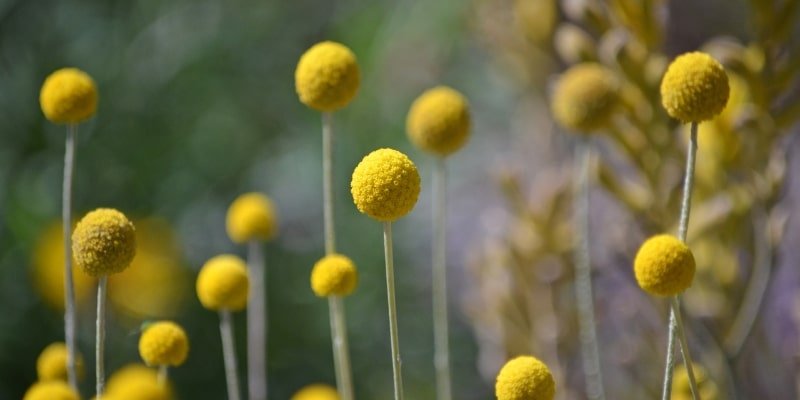
Scientific Name: Craspedia globosa
Plant Type: Perennial
Plant Size: 4 – 24 inches
Sun Exposure: Full sun or partial shade
Plant Zone: 8 – 11
Geographic Origin: New Zealand and Australia
Given that craspedia plants are long, slender plants with dense yellow flowers that create a ball at the top of their stems, they’re a great way to add a distinctive touch to your yard. Actually, this plant is commonly referred to as “golden drumsticks.”
With Craspedia, you can have yellow blossoms in your home all year round. It’s an excellent plant for drying. But you should anticipate that the golden hue may fade over time.
16. Dahlia

Scientific Name: Dahlia
Plant Type: Perennial
Plant Size: 1 – 6 feet tall
Sun Exposure: Full sun
Plant Zone: 8 – 10
Geographic Origin: Central America, Mexico
Sunflowers and daisies belong to the same family as dahlias. Their flowers bear similarities to each other; the layers of tiny petals resemble sunflowers, while the tight yellow center is reminiscent of a daisy.
Dahlia tubers were once consumed by humans in the Aztec era. People today appreciate these flowers for their colours because, following the Spanish invasion, the fad never gained traction in Europe. Dahlias thrive in well-drained soil that receives regular irrigation.
17. Goldenrod

Scientific Name: Solidago virgaurea
Plant Type: Perennial
Plant Size: 1.5 – 5 feet tall
Sun Exposure: Full sun
Plant Zone: 3 – 9
Geographic Origin: North America, Europe, Asia
The enormous yellow-flowering plant known as goldenrod is sometimes considered a weed, but it has many beneficial herbal uses, particularly for the kidneys. It often grows by the sides of roadways and blooms from June to September with deep golden flowers.
In dry, calcareous, and loamy soil, goldenrod thrives nicely. Due to its rapid expansion, many individuals choose to gather it in its natural habitat. However, you can cultivate it for use in wild herb salads if you’d like to plant it in your garden.
18. Mecardonia
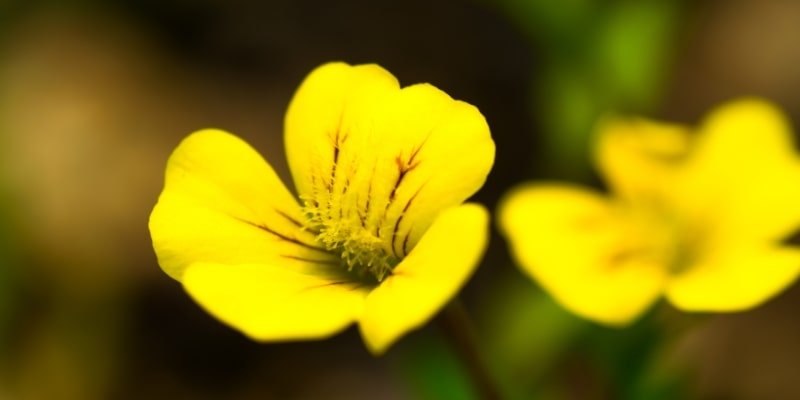
Scientific Name: Mecardonia procumbens
Plant Type: Annual or perennial, based on the temperature
Plant Size: 2 – 5 inches
Sun Exposure: Full sun
Plant Zone: 10a – 11b
Geographic Origin: The Americas
Macedonia, often known as ‘gold dust,’ is a low-lying plant with dozens of tiny golden flowers that give the impression of ‘dusting’ your yard.
If you make sure the soil has enough moisture, you’ll be able to enjoy lovely blooms from spring until frost. Mecardonia only ever produces yellow flowers, so you don’t have to be concerned about purchasing the wrong colour by mistake like you would with many other plants on this list.
19. Night-Blooming Jasmine

Scientific Name: Cestrum nocturnum
Plant Type: Perennial
Plant Size: 6 – 15 feet tall
Sun Exposure: Full sun or partial shade
Plant Zone: 8 – 11
Geographic Origin: South America, West Indies
The night owl loves the night-blooming jasmine. These plants release a waft of pleasant aroma in the evening when their long, slender golden flowers open.
The Night-Blooming Jasmine makes an ideal choice for privacy hedges due to its tall growth habit. Some like to grow it close to windows they leave open so they can smell it inside their houses at night.
20. Purslane

Scientific Name: Portulaca oleracea
Plant Type: Annual or perennial
Plant Size: 4 – 10 inches tall
Sun Exposure: Full sun
Plant Zone: 5 – 10
Geographic Origin: North Africa, Southern Europe
Aside from its yellow blossoms, purslane is an excellent tiny herb because of its thick, compact leaves. Though the flowers on this plant are modest, if you kneel to appreciate their yellow colour, you will notice that each of the five petals has a heart-shaped snip at the tip.
Purslane’s deep taproot helps it resist drought and poor soil conditions. The fact that one seed can yield more than 190,000 seeds is equally astounding.
21. Snapdragon

Scientific Name: Antirrhinum
Plant Type: Perennial
Plant Size: 6 – 48 inches tall
Sun Exposure: Full or partial sun
Plant Zone: 7 – 11
Geographic Origin: Mediterranean, Europe, Syria
Gardeners love snapdragons not only for their striking array of colors, which includes yellow but also for the graceful shape of their blossoms. The jaw-like characteristic of these blooms is so distinctive that only giant bumblebees are able to open them for pollination.
In spring and fall conditions, your snapdragons should bloom. Given that they begin at the base of the stalk and open their petals at the top, they provide a stunning display of blossoming.
22. Water Lily
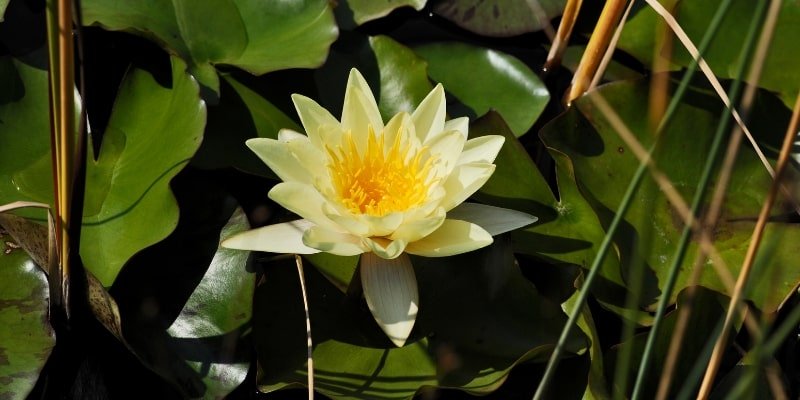
Scientific Name: Nymphaea Hollandia
Plant Type: Perennial
Plant Size: 3 – 6 feet tall
Sun Exposure: Full sun
Plant Zone: 4 – 10
Geographic Origin: Asia, Australia, North America
All of the flowers we have discussed thus far are terrestrial. On the other hand, freshwater is home to the water lily, which emerges from lily pads. For these plants to display their vivid blossoms, which are perched atop tall stalks that extend six inches or more above the water, they require moderate to tropical climates.
There are numerous hues in water lilies. There are variants that are only yellow, and others that have white pedals with a big yellow centre. For these plants to develop, the water must move slowly.
23. Daffodil

Scientific Name: Narcissus
Plant Type: Perennial
Plant Size: 6 – 30 inches tall
Sun Exposure: Full or partial sun
Plant Zone: 4 – 8
Geographic Origin: Europe, North America
The trumpet-shaped flowers and broad, glossy, upturned leaves of daffodils, an iconic bulb plant, lend character to gardens. Due to their incredible popularity, daffodils come in a wide range of colours. Thus, you have the option of selecting a yellow flower that is plain yellow or one that is yellow with another colour.
The length of the daffodil’s leaves typically leaves it only a few inches shy of the flower’s height. Don’t overshadow daffodils when planting them; too much shade will prevent them from blossoming.
24. Graham Thomas Rose

Scientific Name: Rosa
Plant Type: Perennial
Plant Size: 5 – 12 feet tall
Sun Exposure: Full sun or partial shade
Plant Zone: 5 – 8
Geographic Origin: United Kingdom
There are many different kinds of roses, but if you want to discover yellow-flowering plants quickly, we suggest you start with the Graham Thomas Rose. Although the Graham Thomas has all of the traditional qualities you would expect from a rose, their rich yellow-gold hue sets them apart from most of the flowers we have discussed thus far.
These plants work well in containers as well as hedges. They will likely flower several times between late spring and early winter.
25. Marigold

Scientific Name: Tagetes spp.
Plant Type: Annual
Plant Size: 4 – 48 inches tall
Sun Exposure: Full sun
Plant Zone: 2 – 11
Geographic Origin: Mexico
The lovely marigold has therapeutic qualities that aid in wound healing in addition to being a beautiful yellow flower. Moreover, marigolds draw beneficial insects to your yard and keep away pests that could harm your other plants.
Because marigolds flower for a long time—from June to October—we adore them. Marigold flowers are used as decorations by many, but they can also be eaten raw in a salad. Rich, loose, and airy organic soil is necessary for them.
26. Pansy

Scientific Name: Viola x wittrockiana
Plant Type: Perennial, annual, or biennial
Plant Size: 4 – 8 inches tall
Sun Exposure: Full or partial sun
Plant Zone: 7 – 11
Geographic Origin: Europe, Asia
Pansies are available in various hues, such as big yellow or yellow flowers with different colors. This plant is quite spectacular, with three-inch-diameter flowers that have two overlapping upper and side petals and one petal underneath.
These petals frequently contain a variety of colors and patterns, which allows you to add extra vibrancy to your attempt to create a yellow flower. Pansies can tolerate medium soil quality and light frosts despite their delicate appearance.
27. Sunflower
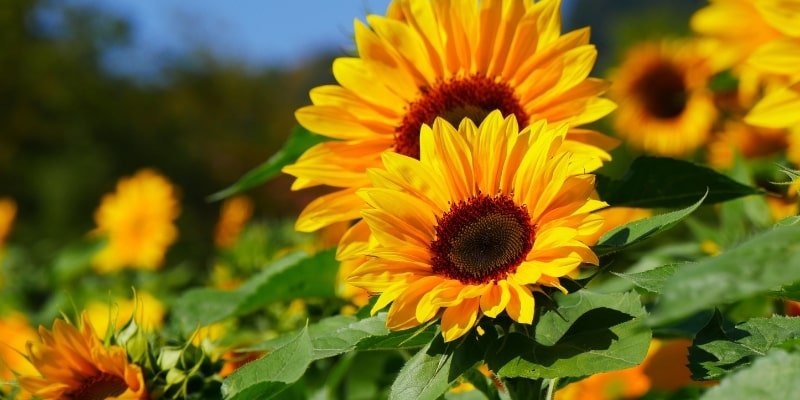
Scientific Name: Helianthus annuus
Plant Type: Annual
Plant Size: 3 – 10 feet tall
Sun Exposure: Full sun
Plant Zone: 2 – 11
Geographic Origin: North America
Sunflowers are late-summer and autumn plants that most of us are familiar with and adore. This plant, as its name suggests, requires full sun and will face the sun with its vast head and golden flowers.
Because it requires little care and upkeep, this annual flowering plant is a favourite in gardens. While some cultivate sunflowers for their striking yellow colour, others do it in order to collect the seeds.
We won’t pass judgment on your decision! On the other hand, you can count on birds to harvest the seeds if you don’t. Because they are hardy and simple to grow, sunflowers are summertime favourite for many gardeners.
28. Calendula

Scientific Name: Calendula officinalis
Plant Type: Perennial
Plant Size: 1 – 2 feet tall
Sun Exposure: Full sun or partial shade
Plant Zone: 9 – 11
Geographic Origin: Southern Europe
You may be familiar with marigolds even if you are unfamiliar with the word Calendula. Since the family Calendula contains up to 20 species, Calendula is the potted equivalent of a marigold.
The vibrant to deep yellow blooms of calendulas are pom-pom-like and quite striking. The flowers are even edible and can be picked and used in salads. Calendula also has several medicinal uses, and it’s usually seen in herbal and cosmetic goods.
29. Carolina yellow jasmine

Scientific Name: Gelsemium sempervirens
Plant Type: Perennial
Plant Size: 12 – 36 feet tall
Sun Exposure: Full sun
Plant Zone: 7 – 10
Geographic Origin: Southern United States
Fun fact: South Carolina’s official flower is the Carolina yellow jasmine. Growing from its vine are pretty little yellow blooms. These flowers typically bloom from February to May, so you can anticipate seeing them before a lot of other plants.
Soils that are slightly salted are ideal for Carolina yellow jasmines. Without a trellis, they will grow bushy, which can make for visually appealing ground cover.
30. Coneflower

Scientific Name: Echinacea
Plant Type: Perennial
Plant Size: 2 – 5 feet tall
Sun Exposure: Full or partial sun
Plant Zone: 3 – 8
Geographic Origin: North America
The yellow petals of the yellow coneflower resemble those of the black-eyed Susan, emerging from a deep brown center that makes them easy to confuse for one another. It can resist droughts because of its long taproot.
Coneflower belongs to the Echinacea family and is used by individuals to strengthen their defenses against colds and flu. There is a widespread belief that it can also mitigate the intensity of a cough, fever, and sore throat.
31. Daisy

Scientific Name: Bellis perennis
Plant Type: Perennial
Plant Size: 6 – 12 inches
Sun Exposure: Partial sun
Plant Zone: 4 – 8
Geographic Origin: Europe
You may vary the amount of yellow you add to your garden by growing daisies, a pleasant yellow flower to grow. Most people picture the traditional daisy, which has white petals and a vivid yellow center.
On the other hand, daisies with yellow centers and yellow petals are also available for purchase. Since most daisies can thrive in medium- to sandy soil, they usually don’t need soil treatment.
But it’s imperative to make sure these plants receive adequate water. If not, their blossoms will drop, and they will become brittle.
32. Dutch Hyacinth

Scientific Name: Hayacinthus orientalis
Plant Type: Perennial
Plant Size: 6 – 12 inches tall
Sun Exposure: Full or partial sun
Plant Zone: 4 – 8
Geographic Origin: Europe, Asia
Bulb plants called hyacinths have yellow flowers that emerge from a strong, upright stalk. The flowers feature thin, curling petals and an elaborate look. Take the blooms off the stalk as soon as they die to prevent the plant from using its energy to make seeds.
Right up until they blossom, these plants prefer moist soil. It’s advisable to cut back on how often you water them after that. Home deodorizers frequently employ hyacinths because of their pleasant aroma.
33. Hellebores

Scientific Name: Hellebores spp.
Plant Type: Perennial
Plant Size: 1 – 2 feet tall
Sun Exposure: Summer shade and winter sun
Plant Zone: 3 – 9
Geographic Origin: Middle East
Despite having a rose-like appearance, hellebores are actually an evergreen that flowers early, from February to May. Remarkably, the yellow flower you see blooms not from the actual plant but from its protective sepals.
Aside from needing well-draining soil, hellebores are relatively easy to care for. This plant is also resistant to deer. Thus, you won’t have to worry about the deer ruining your time admiring your garden’s yellow blooms. Shade gardens can benefit significantly from the shade-loving nature of this perennial.
34. Petunia

Scientific Name: Petunia spp.
Plant Type: Annual
Plant Size: 6 – 24 inches tall
Sun Exposure: Full sun
Plant Zone: 10 – 11
Geographic Origin: South America
In addition to numerous colours and patterns, the delicate trumpet-shaped Petunia blooms in a bright yellow hue. Because their flowers last from spring until the first frost, you’ll adore the color they add.
Surprisingly, petunias are durable. If the soil drains properly, they can grow in a wide range of soil types, though they prefer slightly fertile soil. For hanging baskets, these plants are great.
35. Wishbone Flower

Scientific Name: Torenia fournieri
Plant Type: Annual
Plant Size: 6 – 12 inches tall
Sun Exposure: Partial shade
Plant Zone: 2 – 11
Geographic Origin: Asia
Lower-lying plants that defy appearances, wishbone flowers are incredibly resilient. They can tolerate intense heat, making them great for folks who aren’t very green.
It was the wishbone-like shape of its stamens that gave rise to the name Wishbone Flower. From late April until the first frost, these flowers are in bloom. In order to preserve the health of the remaining blooms, we strongly advise you to deadhead-withering flowers.
36. Yellow Carnation

Scientific Name: Dianthus caryophyllus
Plant Type: Perennial
Plant Size: 12 – 18 inches tall
Sun Exposure: Full or partial sun
Plant Zone: 7 – 10
Geographic Origin: Southern Europe
There are two ways to have yellow carnations: either pick white carnations and add yellow food coloring to the water in the vase or choose a breed that spontaneously produces yellow flowers. You will be able to appreciate the clove aroma of these blooms in either scenario.
To flourish, yellow carnations need soil that is both alkaline and well-draining. If you would like them to bloom again later in the year, we advise deadheading them after the first bloom.
37. Yellow Oleander

Scientific Name: Nerium oleander
Plant Type: Perennial
Plant Size: 8 – 12 feet tall
Sun Exposure: Full or partial sun
Plant Zone: 8 – 10
Geographic Origin: Southern Asia, Mediterranean
If you want to add some yellow flowers to your yard, yellow oleanders make a stunning addition to your landscaping. The shrub is bushy and grows in temperate to tropical climates, as seen by its lustrous, deep green leaves.
Yellow oleanders have a decent chance of surviving in both drought and flooding. They will, however, perish in a frost.
38. Zinnia

Scientific Name: Zinnia elegans
Plant Type: Continual or annual, based on temperature
Plant Size: 1 – 4 feet tall
Sun Exposure: Full sun
Plant Zone: 2 – 11
Geographic Origin: South America, Mexico
We offer you the Zinnia, a fast grower and prolific bloomer, to complete this selection of yellow flowers. A solitary yellow flower with a structure resembling a daisy is produced by each stem.
It’s important to keep in mind that nurseries often carry three varieties of Zinnia flowers: single, semi double, and double. Choose the single or semi double if you want a centre that is visible. The double blossom, however, provides a fantastic show with additional petals.
39. Bear’s Ear

Scientific Name: Primula auricula
Plant Type: Perennial
Plant Size: 6 – 8 inches tall
Sun Exposure: Partial sun or full shade
Plant Zone: 3 – 8
Geographic Origin: Central Europe
Bear’s Ear, a stunning plant, gets its name from its leaves that resemble bear ears. On mountain slopes in central Europe, this plant frequently grows between boulders.
On top of 2 to 8-inch-long stalks, clusters of vivid yellow flowers bloom on the bear’s ear. Five petals, all of the same vivid yellow colour, connect to a small button-like center in each flower. Blooms are framed by a basal rosette of foliage.
40. Bulbous Buttercup

Scientific Name: Ranunculus bulbosus
Plant Type: Perennial
Plant Size: 1 – 2 feet tall
Sun Exposure: Partial or full sun
Plant Zone: 4 – 8
Geographic Origin: Europe
Buttercups, which frequently grow in fields that range from nutrient-rich to calcareous with limestone, are easily recognized by their buttery colour. They are a springtime flower that blooms from March to May with upward-facing petals.
The bulb knot at the base of the stems and blooms of Ranunculus bulbosus gives rise to the species’ name. But until you draw back the sepals covering it, you can miss it.
41. Canna Lily

Scientific Name: Canna
Plant Type: Annual
Plant Size: 1.5 – 10 feet tall
Sun Exposure: Full sun
Plant Zone: 8 – 11
Geographic Origin: Caribbean
You need look no further than the canna lily if you’re searching for a tall, striking yellow flower plant. Massive yellow flowers are produced on sturdy stalks with broad green leaves, which are pretty easy to grow.
The tropical flare that canna lilies add to gardens is why people in colder climates love to grow them. Canna lilies grow well in damp soil; however, they can also be found in bogs.
It is imperative that you provide this plant with an abundance of organic matter and make sure the pH of the soil is between neutral and slightly acidic.
42. Chrysanthemum

Scientific Name: Chrysanthemum
Plant Type: Perennial
Plant Size: 4 – 36 inches tall
Sun Exposure: Full sun
Plant Zone: 5 – 9
Geographic Origin: Asia and Europe
You may expect a yard full of big, eye-catching blooms because chrysanthemums belong to the same family as daisies and sunflowers. The tight packing of dozens of small petals to form the bloom is what gives these flowers their exquisite appearance. Walking by the fragrant chrysanthemum flower is a delightful experience.
In addition, these plants are available in white with light yellow centers, which contrasts beautifully with the pure yellow varieties. You may also get them in deep yellow.
43. Coreopsis

Scientific Name: Coreopsis
Plant Type: Annual or perennial, based on the temperature
Plant Size: 2 – 4 feet tall
Sun Exposure: Full sun
Plant Zone: 2 – 11
Geographic Origin: North America
Planting Coreopsis is a delight since it yields an abundance of flowers that attract a wide variety of butterflies. Although it can be found in various colours, the yellow variation features light yellow leaves with a dark orange center.
These flowers should be appreciated beginning in the early summer. Rich, nutrient-rich soil that drains appropriately is ideal for Coreopsis plant growth.
It can, however, tolerate arid climates and less favourable soil conditions. For further blooms throughout the growing season, we strongly advise you to deadhead these plants.
44. Freesia

Scientific Name: Freesia spp.
Plant Type: Perennial
Plant Size: 1 – 2 feet tall
Sun Exposure: Full or partial sun
Plant Zone: 9 – 10
Geographic Origin: Africa
Beautiful plants, freesias have delicate petals that bend upward while in bloom. Their sparsely leafed stalk supports six tepals that mature into funnel-shaped blooms.
Many businesses use freesias to perfume candles, shampoo, and hand care. They are a typical plant at weddings. Make sure that the moisture content of your freesia plants is moderate.
They will develop root rot if you overwater them. A great strategy to ensure that this plant produces abundant blooms is to add potassium to the soil every two weeks after the first yellow buds show.
45. Iris

Scientific Name: Iris pseudacorus
Plant Type: Perennial
Plant Size: 12 – 40 inches tall
Sun Exposure: Full sun
Plant Zone: 3 – 9
Geographic Origin: Southern Europe, Mediterranean
The heavenly iris blooms from April through June with stunning blooms. The flowers, which have a variety of colours, including yellow, are borne atop upright peduncles.
A complete and spectacular appearance is provided by the many blossoms that adorn each stem of the peduncle. Prolonged droughts are not a problem for iris plants because of their robust rhizomes.
Their fast-spreading nature gives those features similar to those of wildflowers despite their beauty. Additionally, be cautious when touching them, as they may cause skin irritation.
46. Lantana

Scientific Name: Lantana camara
Plant Type: Perennial
Plant Size: 6 feet high
Sun Exposure: Full sun
Plant Zone: 7a – 11a
Geographic Origin: Tropical Americas, West Indies, Mexico
A great decorative plant for landscaping is the shrubby lantana. At the tips of its stems are clusters of tiny blooms. The ever-changing colours of the flowers on lantanas are what attract gardeners so much. Usually, it begins as a white blossom and develops into a variety of colours, including yellow.
Except for Antarctica, lantana grows on every continent. It is sterile because of the breeding practices used by many nurseries. You won’t have to be concerned about it growing in the wrong place in such a scenario.
47. Moss Rose

Scientific Name: Portulaca grandiflora
Plant Type: Annual
Plant Size: 3 – 9 inches tall
Sun Exposure: Full sun
Plant Zone: 2 – 11
Geographic Origin: South America
Yes, Moss Rose’s slender and plentiful leaves give it a bush-like, moss-like appearance. This plant produces puffy, beautiful flowers throughout the summer.
However, be careful whatever variety you buy, as some have many different coloured flowers on a single plant, while other variants have all yellow flowers with reddish-orange centers.
Cuttings of the deer-resistant Moss Rose are a good way of propagating. It is also a hardy plant, despite its preference for damp, nutrient-rich soil.
48. Yellow Hibiscus
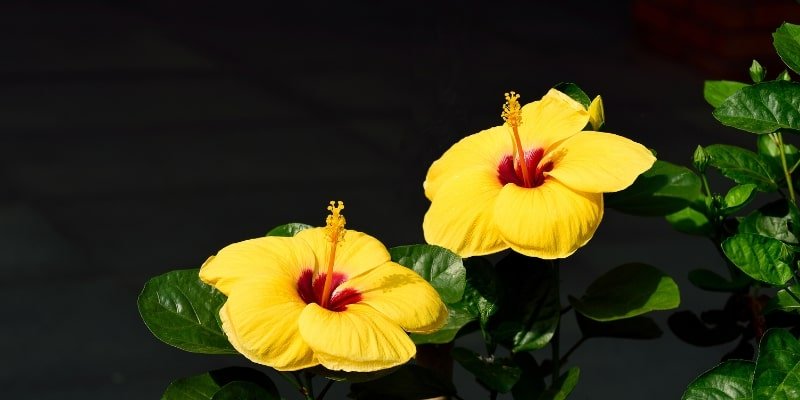
Scientific Name: Hibiscus rosa-sinensis
Plant Type: Perennial
Plant Size: 4 – 10 feet tall
Sun Exposure: Full or partial sun
Plant Zone: 9 – 11
Geographic Origin: Asia
The hibiscus plant has wonderful therapeutic qualities in addition to its lovely flower. Hibiscus is a popular tea that has a tangy flavour and is high in vitamin C. Some even dry-candle the bloom to eat it raw or use it in recipes.
Make sure you get the yellow kind of hibiscus before purchasing, as the red and white varieties are frequently preferred. Either way, you may anticipate stunning trumpet-shaped flowers with five or more petals from this shrub.
49. Yellow Tulip

Scientific Name: Tulipa spp.
Plant Type: Perennial
Plant Size: 9 – 24 inches tall
Sun Exposure: Full sun
Plant Zone: 3 – 8
Geographic Origin: Central Europe, Eastern Asia
Among all the plants on this list, tulips’ enormous, cup-shaped petals are among the most recognizable. Springtime brings us tulips, single-stemmed flowers with three petals that grow around their sepals.
You have the option of selecting yellow tulips or yellow tulips streaked with a different colour. Tulip bulbs need to be planted in the autumn, unlike many other plants.
50. Blanket Flower

Scientific Name: Gaillardia x Grandiflora
Plant Type: Perennial
Plant Size: 24 – 36 inches tall
Sun Exposure: Full sun
Plant Zone: 3 – 10
Geographic Origin: North America
If you want yellow flowers with two tones in your yard, blanket flowers are a great plant to add. The centers of these plants are deeply reddish-brown, and as they spread out, they become yellow in hue. This plant will bloom from June until the first frost if you deadhead it.
The pale green, fluffy leaves of the blanket flower are thin. In stony soil with minimal moisture, these plants do well. You may usually find them growing in arid meadows and plains. Perfect for sunny garden locations, this perennial flower loves the sun.
51. Corydalis

Scientific Name: Corydalis Canadensis
Plant Type: Perennial
Plant Size: 12 – 18 inches
Sun Exposure: Shade or partial sun
Plant Zone: 5 – 7
Geographic Origin: Northern hemisphere
Corydalis plants come in various colours, and the variety of yellow will make your yard look charming. But if you’d instead not go with a solid yellow hue, think about getting the pink kind with yellow tips on the petals.
Garden aficionados love the Corydalis, a beautiful plant that is a member of the poppy family. Although research on the effectiveness of corydalis tubers in treating pain and high blood pressure is ongoing, some people in the East use them for these purposes.
52. Daylily

Scientific Name: Hemerocallis
Plant Type: Perennial
Plant Size: 5 feet and 8 inches tall
Sun Exposure: Full or partial sun
Plant Zone: 3 – 10
Geographic Origin: Asia, Central Europe
Daylilies bloom from early to midsummer, producing flowers fit for a show. The flowers can reach a diameter of more than eight inches, and they frequently come in a spectrum of yellow tones, such as yellow and orange-streaked flowers.
The drawback of daylilies is that they only have one day of blooming before they fade. On the other hand, you will be able to enjoy their flowers for the full three to four weeks that they continuously produce flowers.
53. Leontodon

Scientific Name: Leontodon rigens
Plant Type: Perennial
Plant Size: 18 inches tall
Sun Exposure: Light to partial shade
Plant Zone: 8 – 9
Geographic Origin: Eurasia, North Africa
Leontodons are an excellent choice for a tropical-looking plant in a temperate region. Their shiny, broad leaves frequently steal the scene. However, you will be treated to tiny daisy-like flowers in clusters that rise above the leaves when this plant flowers, which happens in the summer.
Leontodon favours loamy soil that drains well over average soil. This plant does better in more shade the hotter your climate is.
54. Bulbine
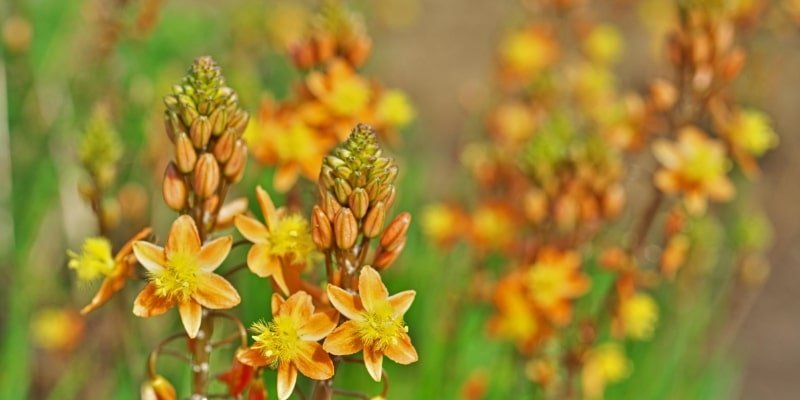
Scientific Name: Bulbine frutescens
Plant Type: Perennial
Plant Size: 1 – 1.5 feet
Sun Exposure: Full sun
Plant Zone: 9 – 11
Geographic Origin: South Africa
Are you trying to find a ground cover with yellow flowers? The Bulbine plant is a beautiful choice if this is the case and you reside in a dry climate free of frost.
Bulbine’s clumping habit permits each plant to spread four feet in diameter without the fast growth that some other plants have, which can be an annoyance. The flowers of bulbs are yellow and orange, and they bloom several times a year.
However, it’s imperative that you put them in a shaded area. If not, you might not even notice their golden blossoms.
55. Primrose

Scientific Name: Primula spp.
Plant Type: Perennial or annual
Plant Size: 6 to 20 inches in height
Sun Exposure: Partial sun or full shade
Plant Zone: 2 – 8
Geographic Origin: North and South America, Europe
A lovely spring flower, primroses grow well as ground cover or in containers. Their golden flowers with heart-shaped leaves are expected to last until the summer. However, if your temperature is warm enough, the blossoms can persist into the autumn.
It’s best to plant primrose next to or inside the woods. They do not withstand intense sunshine well and prefer damp soil. Primroses require rich soil because they are found in wooded environments in the wild.
56. Yellow Pincushion
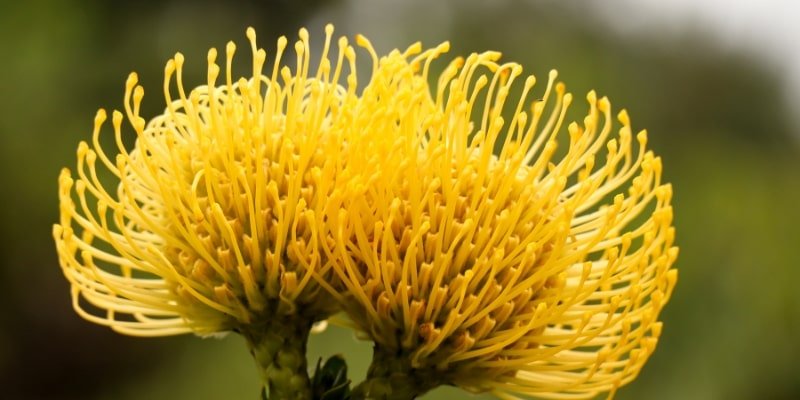
Scientific Name: Chaenactis glabriuscula
Plant Type: Evergreen shrub
Plant Size: 1 – 2 feet high (30 – 60 cm)
Sun Exposure: Bright, indirect sunlight
Plant Zone: 8 to 11
Geographic Origin: Eurasia and Africa
Pincushion plants, a beautiful perennial, go well with a variety of other garden plants. The lovely pincushion flower is typically seen in stunning sky blue hues, but you may also find it in black-purple, lilac, pink, and white.
The pincushion plant and its blooms can easily find a home in any garden because of how nicely these gentle tones complement so many various types of plants.
The pincushion flower’s foliage is likewise not too noticeable; it grows in a lovely mat with slightly divided leaves that serve as a stunning background for this beautiful bloom.
57. Yellow Lady’s Slipper
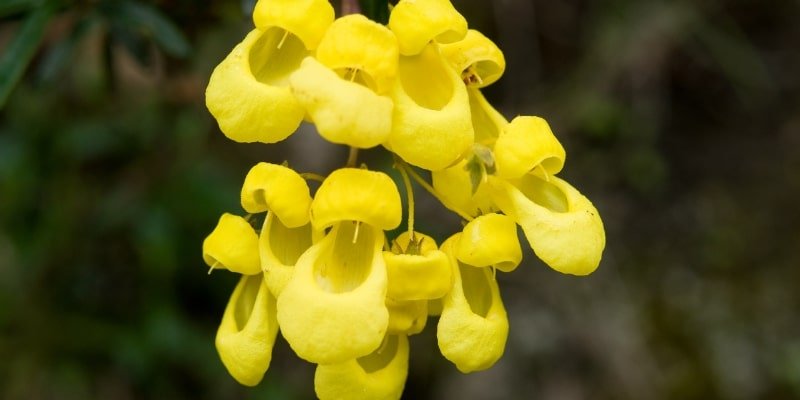
Scientific Name: Cypripedium parviflorum
Plant Type: Perennial
Plant Size: 12–80 cm
Sun Exposure: Full sun, Partial Shade
Plant Zone: 2 to 9
Geographic Origin: North America
Lady slipper orchids are uncommon, endangered, or have distinctive colour patterns and shapes. Lady slipper orchids are the most primitive species still in existence today, and they belong to the orchid genus Cypripedium.
The majority are terrestrial, developing on the earth in temperate regions worldwide. The genus includes moccasin flowers, which are native to the northern hemisphere, and lady slipper orchids, which are distinguished by a pouched lip that resembles a shoe or slipper toe.
These uncommon orchids are sluggish in germinating and spreading, and they have very particular growth requirements.
58. Yellow Ginger Lily

Scientific Name: Hedychium flavescens
Plant Type: Perennial
Plant Size: 3-6 ft. high & 2-3 ft. wide
Sun Exposure: Full sun to Partial Shade
Plant Zone: 8 to 11
Geographic Origin: Himalayas in India, Nepal, and Bhutan
Hedychium, the genus of beautiful ginger lilies, has roughly thirty distinct species, and the Atlanta Botanical Garden sells sixty hybrids and cultivars. The parents and species of a ginger lily can affect how it looks.
59. Yellow Wood Sorrel

Scientific Name: Oxalis stricta
Plant Type: Perennial
Plant Size: 23 cm
Sun Exposure: Full Sun
Plant Zone: 5 to 11
Geographic Origin: North America, parts of Eurasia
A perennial weed belonging to the Oxalidaceae (wood sorrel) family is called common yellow wood sorrel. In many grass and garden regions, yellow woodsorrel is regarded as an aggressive weed that thrives in low-nutrient soil.
In warmer areas, plants can be found all year round, but they grow most quickly in the spring or autumn. These plants increase through rhizomes, stolons, and rapidly germinating seeds. Oxalis likes alkaline, sandy-loam soils that drain well, from dry to damp.
60. Honeysuckle

Scientific Name: Lonicera periclymenum
Plant Type: Perennial, Shrub, Groundcover, Vine
Plant Size: 15-17 cm
Sun Exposure: Daily Sunlight
Plant Zone: 5 to 9
Geographic Origin: Southern Asia and North Africa
The bi-coloured tubular blossoms and lustrous oval leaves of the gold flame honeysuckle (Lonicera x heckrottii) make it an ideal vine perennial for decorative usage on arbours, trellises, and fences.
The gold flame honeysuckle is deciduous in colder regions and semi-evergreen in warmer climes. Which attract pollinators like butterflies and hummingbirds throughout the summer months when they reach their height?
As suggested by its name, the gold flame honeysuckle looks like a burst of fireworks; its gorgeous pink petals combine with coral or yellow ones to give a beautiful splash of colour.
Though you wouldn’t want to eat them, gold flame honeysuckle occasionally produces berries that attract birds. Eye-catching blooms are also resistant to deer.
61. St. John’s Wort

Scientific Name: Hypericum perforatum
Plant Type: Herbaceous with a perennial
Plant Size: 3 feet high by 2 feet wide
Sun Exposure: Daily Sunlight
Plant Zone: 4 to 9
Geographic Origin: Europe, northern Africa, and western Asia
A landscape workhorse, St. John’s wort excels at providing wildlife, especially pollinators, food and shelter. The shrub is simple to include in practically any landscape and is straightforward to grow.
St. John’s wort is also an excellent plant for landscapes infested with deer and rabbits because these devouring pests rarely graze it. Because of this, the plant is frequently observed growing untamed by highways, grasslands, and open forests.
Actually, because of its creeping growth behaviour, it goes by several popular names, such as goatweed, rosin weed, Tipton weed, Klamath weed, and devil’s.
62. Yellow Monkeyflower

Scientific Name: Erythranthe guttata
Plant Type: Annual
Plant Size: 10-80 cm tall
Sun Exposure: Full or partial sun exposure
Plant Zone: 2 to 8
Geographic Origin: Eastern North America
A genus of flowering annuals and perennials, monkey flowers are prized for their vibrant blooms and capacity to draw pollinators.
These low-maintenance plants may thrive best in sandy, well-drained soil with full sun or in moist soil with partial shade, depending on the species. Monkey flowers are named after their blooms, which are said to resemble the face of a monkey.
Certain monkey flowers are annuals, while others grow best as ground cover or in arid, desert-like environments. It’s critical to understand the type of variety you have and what it requires to survive.
63. Yellow Alpine Poppy

Scientific Name: Papaver alpinum
Plant Type: Perennials
Plant Size: 5 to 20 cm
Sun Exposure: Full Sun
Plant Zone: 2 to 6
Geographic Origin: Eurasia and North Africa
The vivid red blossoms of the perennial wildflower Papaver alpinumare its defining feature. Papaver alpinum seeds can remain dormant for up to 80 years before sprouting when the ground is disturbed. Because of this, it was adopted as a symbol of remembering following World War I, when churned-up battlefields began to grow poppies.
Usually, the Papaver alpinum blooms from late spring to early summer. Although the flowers are typically fiery red, careful breeding and hybridization have produced a number of cultivators with blooms that are yellow, orange, pink, or white in colour.
When planted in their hardiness zones, these poppies require little care and are excellent for naturalizing. They also function well in borders, pollinator gardens, cottage gardens, and garden beds.
64. Canary Creeper

Scientific Name: Tropaeolum peregrinum
Plant Type: Annual climbing herb
Plant Size: 1.8–3 m
Sun Exposure: Full Sun
Plant Zone: 9 to 10
Geographic Origin: South America
Among the more than 80 different plants in the Tropaeolum genus, which includes perennial and annual flowering species, are Tropaeolum peregrinum plants. When planted in the spring, once the risk of frost has subsided, they grow quickly and effortlessly.
A little neglect is what makes them thrive. Tropaeolum peregrinum blooms typically lean toward the hot end of the colour range. The leaves are circular and resemble little lotus leaves.
65. Arnica

Scientific Name: Arnica Montana
Plant Type: herbaceous perennial
Plant Size: 10–70 cm
Sun Exposure: Full Sun
Plant Zone: 4 to 9
Geographic Origin: North America
Areca palms resemble clusters of bamboo because they are tall, showy, and clumping palms with smooth, occasionally golden trunks.
Their fronds resemble bamboo leaves in that they are complete and thin. Tiny, hardly noticeable bright yellow flowers emerge between the fronds during the summer.
The palm is a ubiquitous sight in outdoor plantings in the United States, where it grows in warm climes, frequently bordering sidewalks, or is used as a privacy screen, despite being an endangered species in its native Madagascar. It is a much-liked houseplant as well. These are rare flowering palms when planted indoors.
Conclusion
Which yellow flowers are you leaning towards, then? Recall that a lot of the plants we discussed here can have a wide range of colours. To be sure your flowers will be yellow, confirm one more with the nursery before purchasing.
You should be able to get a variety of vibrant flowers if you cultivate each plant according to its recommended growing conditions. Additionally, you may have yellow flowers from spring through autumn, depending on which ones you plant.

